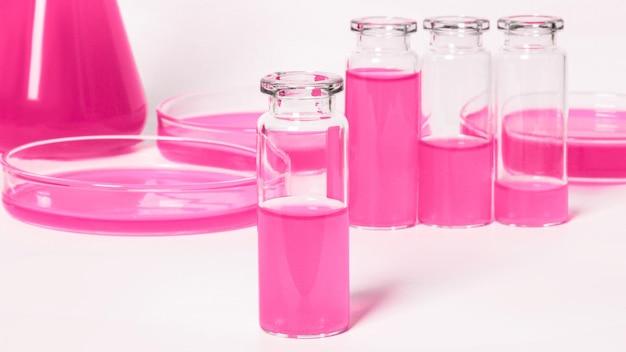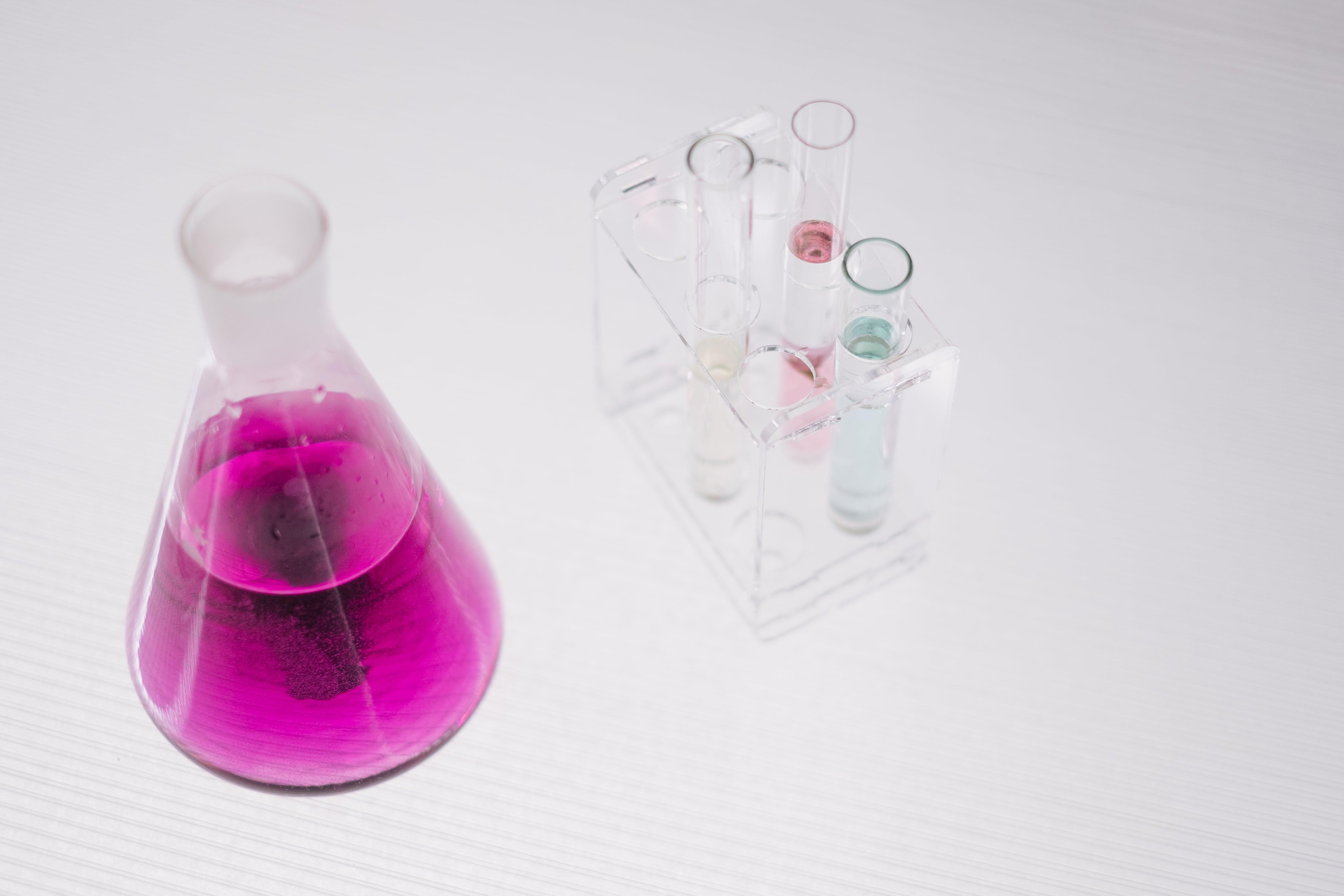Do you ever wonder why phenolphthalein turns a vibrant pink color when added to a basic solution? This fascinating color change is a result of the chemical properties of phenolphthalein and the reaction that occurs in the presence of a base. In today’s blog post, we will dive deeper into the science behind this phenomenon and explore the reasons behind this visual transformation.
Phenolphthalein is a commonly used indicator in chemistry experiments and titrations. When added to a basic solution, such as sodium hydroxide (NaOH), it undergoes a chemical reaction that causes it to turn pink. Interestingly, the color change is not immediate but occurs gradually as the concentration of hydroxide ions (OH-) increases. This gives us a visual indication of the solution’s basic nature.
So, what exactly happens when phenolphthalein comes into contact with a base? How does it transform from colorless to pink? To find out, let’s delve into the chemistry involved and uncover the secrets behind the pink hue of phenolphthalein in basic solutions.
Now that we have piqued your curiosity, let’s explore the mechanism behind this fascinating color change and understand the science behind why phenolphthalein turns pink in basic solutions.

Why Does Phenolphthalein Turn Pink in Basic Solutions
Phenolphthalein: the mysterious chameleon of the chemical world. This fascinating compound has the unique ability to change color depending on the pH of its environment. But why does it turn pink specifically in basic solutions? Prepare yourself for a wild ride through the land of alkalinity and bewildering chemistry.
The pH Scale: An Acidic Adventure
To understand the enigma behind phenolphthalein’s pink transformation, we must first unravel the secrets of the pH scale. Picture a rollercoaster with 0 being the stomach-dropping acidity of lemon juice and 14 being the heartwarming alkalinity of drain cleaner. Neutral ground, where pH 7 resides, is like that sigh of relief after a rollercoaster ride.
Acidic Solutions: The Sour Side of Phenolphthalein
In acidic solutions, with a pH below 7, phenolphthalein stays clear as a mountain stream. It avoids the pink spotlight, preferring to skulk in the shadows. Acidic compounds (oh, that sour lemon juice we mentioned earlier) donate hydrogen ions, making the environment positively charged.
Basic Solutions: Phenolphthalein’s Blushing Adventure
But then, the plot thickens. When the solution turns basic, with a pH greater than 7, phenolphthalein transforms into a vibrant pink diva, seizing the lead role in our chemical stage play. As the pH rises, the basic compounds present readily accept hydrogen ions, creating a negatively charged environment.
A Perfect Match: Phenolphthalein and Hydroxide Ions
Now, prepare yourself for the big reveal. Phenolphthalein’s infatuation with basic solutions lies in its love affair with hydroxide ions (OH-). When these ions enter the scene, they gracefully snatch hydrogen ions away from phenolphthalein molecules, forming water. This enchanting dance between hydroxide and phenolphthalein causes the compound to dramatically change color.
The Pink Parade: Phenolphthalein Takes Center Stage
As the basic solution sweeps phenolphthalein into its welcoming arms, the compound undergoes a mind-blowing molecular makeover. It morphs into a heavenly shade of pink, as if coaxed by the allure of a candy store. It’s as if the phenolphthalein molecules can’t resist showing off their fabulous transformation and demanding attention.
A Twist in the Tale: pH Sensitivity
But, dear reader, here’s where things get even more interesting. The intensity of phenolphthalein’s pink hue is determined by the pH level of the solution. The higher the pH, the deeper the pink becomes. It’s like watching a theater curtain rise, unveiling a spectrum of colors that leave us in awe of nature’s hidden secrets.
And there you have it – the captivating explanation behind why phenolphthalein proudly dons its pink attire when mingling with basic solutions. We’ve taken a thrilling journey through the pH scale, witnessed the magical chemistry between phenolphthalein and hydroxide ions, and unraveled the mystery behind its color-changing performance. So, the next time you encounter phenolphthalein turning pink in a basic solution, give it a round of applause for its sensational chemistry skills!

FAQ: Why is Phenolphthalein Pink in Basic Solution
Phenolphthalein is a popular chemical compound used as an indicator in various experiments and titrations. In this FAQ-style section, we will address some commonly asked questions about why phenolphthalein turns pink in basic solutions.
What would be the Color of NaOH Solution when Phenolphthalein Indicator is Added
When phenolphthalein is added to a solution of sodium hydroxide (NaOH), the resulting color is a vibrant pink. It’s like adding a splash of cheerful cotton candy to your chemistry experiment!
What is the Color of Dilute HCl
Dilute hydrochloric acid (HCl) is quite different from sodium hydroxide. When phenolphthalein is added to a solution containing dilute HCl, the color doesn’t change. That means no pink surprise for you this time! The solution remains colorless.
When a Drop of Phenolphthalein is Added to Solution A, it Turns Pink. What is Solution A
Ah, the mysterious Solution A! When phenolphthalein is added and turns pink, Solution A is most likely a basic solution. Basic solutions have a higher pH, and phenolphthalein serves as an indicator by changing color in the presence of bases. So, Solution A is dancing in a basic attire!
Why is Phenolphthalein Pink in Basic Solution
The secret to phenolphthalein’s pink prowess lies in its unique molecular structure. In basic solutions, the concentration of hydroxide ions (OH-) is relatively high. Phenolphthalein molecules eagerly snatch these hydroxide ions and form a complex called phenolphthaleinate, which happens to be pink. So, you can think of phenolphthalein as a color-changing chameleon, happily turning pink when surrounded by those hydroxide ions!
What Happens if Ammonia Gas is Passed into Water Containing a Few Drops of Phenolphthalein Solution
Well, things get a little funky when you bring ammonia gas into the mix! Ammonia is considered a base, just like sodium hydroxide. When ammonia gas is passed into water containing phenolphthalein, the solution turns pink. So, phenolphthalein gets along with ammonia just as well as it does with NaOH. It’s like a chemistry party, and ammonia is the life of it!
What Happens When Phenolphthalein is Added to HCl
Phenolphthalein is a stunning example of chemistry’s sense of irony. When it meets hydrochloric acid (HCl), an acid, it remains colorless. Phenolphthalein is only interested in bases, leaving HCl to carry on with its clear solution. So, no color-changing extravaganza this time, folks!
What Happens When an Acid is Added to a Solution
When an acid is added to a solution, the pH level decreases. Acids bring their acidic nature and establish a sour environment. However, when it comes to phenolphthalein, it remains unaffected by the acidity. So, it’s safe to say that phenolphthalein isn’t bothered by the sour company of acids; it’s only looking for its basic buddies to turn on the pink party lights!
Phenolphthalein, with its enchanting pink transformation in basic solutions, continues to fascinate chemists and science enthusiasts alike. Whether it’s NaOH, ammonia, or a basic solution that turns phenolphthalein pink, this indicator’s chemistry paves the way for colorful experiments! So, grab your lab coat and phenolphthalein, and get ready to dive into the world of vibrant chemical reactions!
